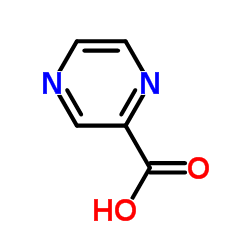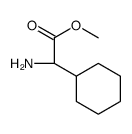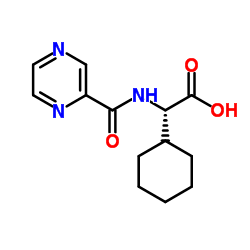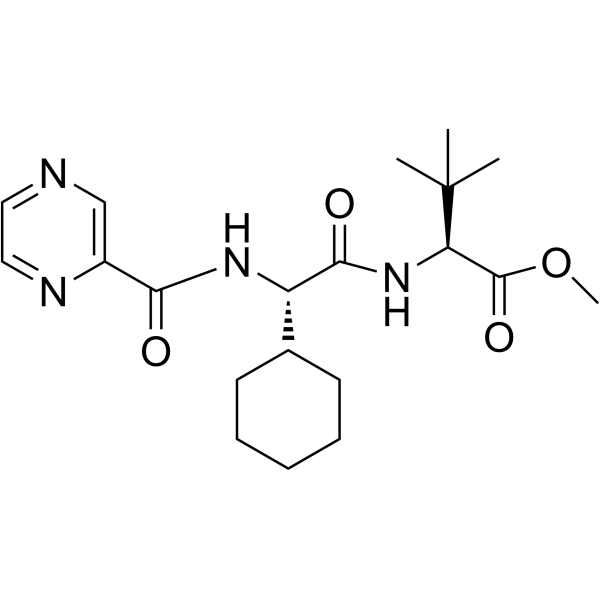| Description |
Telaprevir is a highly selective, reversible, and potent peptidomimetic inhibitor of the HCV NS3-4A protease, the steady-state inhibitory constant (Ki) of Telaprevir is 7 nM against a genotype 1 (H strain) NS3 protease domain plus a NS4A cofactor peptide.
|
| Related Catalog |
|
| Target |
Ki: 7 nM (genotype 1 HCV NS3-4A protease)[1]
|
| In Vitro |
Telaprevir (VX-950) is a covalent, reversible inhibitor of the NS3-4A protease with a slow-binding and slow-dissociation mechanism. Telaprevir exhibits significantly different kinetics in enzyme inhibition, which is most clearly exemplified by a very long half-life (58 min) of the bound enzyme-inhibitor complex. Telaprevir is additive to moderately synergistic with IFN-α in inhibiting HCV replication and in suppressing the emergence of resistance in replicon cells. Telaprevir reduces HCV RNA levels in a time- and dose-dependent manner. The IC50s following a 24, 48, 72, and 120 h incubation with Telaprevir are determined to be 0.574, 0.488, 0.21, and 0.139 μM, respectively, indicating an increase in inhibitory effects with time. Following three independent experiments using the 48 h incubation in the presence of 2% FBS, the average IC50 of Telaprevir is determined to be 0.354 ± 0.035 μM, and the average IC90 is 0.830 ± 0.190 μM[1]. Telaprevir (VX-950) is a potent, selective, peptidomimetic inhibitor of the hepatitis C virus (HCV) NS3-4A serine protease, and Telaprevir demonstrates excellent antiviral activity both in genotype 1b HCV replicon cells (IC50=354 nM) and in human fetal hepatocytes infected with genotype 1a HCV-positive patient sera (IC50=280 nM)[2].
|
| In Vivo |
There is an ~5-fold reduction of serum SEAP activity in mice dosed with Telaprevir (VX-950) at either 10 or 25 mg/kg, which has an average value (±SEM) of 18.7±8.3% or 18.4±5.4%, respectively, compare to those administered vehicle (100±28%). These data demonstrates that Telaprevir is able to inhibit the HCV NS3-4A serine protease activity in mouse liver and block cleavage and subsequent secretion of SEAP into blood circulation in these mice[2].
|
| Cell Assay |
Determination of IC50, IC90, CC50 of Telaprevir (VX-950) or IFN-α in HCV replicon cells is performed. Briefly, 1×104 replicon cells per well are plated in 96-well plates. On the following day, replicon cells is incubated at 37°C for the indicated period of time with antiviral agents serially diluted in DMEM plus 2% FBS and 0.5% DMSO. Total cellular RNA is extracted using an RNeasy-96 kit, and the copy number of HCV RNA is determined using a quantitative RT-PCR (QRT-PCR) assay. Each datum point represents the average of five replicates in cell culture. The cytotoxicity of Telaprevir is measured under the same experimental settings using a tetrazolium (MTS)-based cell viability assay. For the cytotoxicity assay with human hepatocyte cell lines, 1×104 parental Huh-7 cells per well or 4×104 HepG2 cells per well are used. To determine cytotoxicity of Telaprevir against resting PBMC, 1×105 cells per well are incubated with Telaprevir in RPMI-1640 medium (no serum) for 48 h, and the cell viability is determined by the MTS-based assay. To determine cytotoxicity of VX-950 against proliferating PBMC, 1×105 cells per well in RPMI-1640 medium are added to a 96-well plate, which is precoated with anti-human CD3 antibody. The cells are incubated with Telaprevir and anti-human CD28 antibody for 72 h at 37°C, and the cell growth is determined by [3H]thymidine update between the 48th and 72nd h[1].
|
| Animal Admin |
Mice[2] Five groups of 6-week-old SCID mice (6 animals per group) are injected with 109 IFU per mouse of recombinant adenovirus Ad-WT-HCVpro-SEAP through the tail vein. Each group of mice is given two oral administrations of Telaprevir (VX-950) at one of the following doses: 10, 25, 75, 150, or 300 mg/kg. The first Telaprevir dose is given 2 h before the adenovirus injection, and the second dose is given 10 h after injection. An additional group of 10 mice is given vehicle alone. Serum samples are collected 24 h postinjection, and the SEAP activity in each Telaprevir-dosed group is compared to that of the vehicle group. Rat and Dog[2] The intravenous and oral pharmacokinetics of Telaprevir (VX-950) are evaluated in rats and dogs. A group of 3 male Sprague-Dawley rats weighing 250 to 300 g is administered an intravenous bolus dose of 0.95 mg/kg Telaprevir. Serial blood samples are collected in heparinized tubes before dosing and at 0.083, 0.167, 0.25, 0.5, 1, 1.5, 2, 3, 4, 6, and 8 h after dose administration. A group of 3 male beagle dogs (8 to 12 kg) is administered an intravenous bolus dose of 3.5 mg/kg Telaprevir in 10% ethanol, 40% polyethylene glycol 400, and 50% D5W. Serial blood samples are collected in heparinized tubes before dosing and at 0.083, 0.167, 0.25, 0.5, 1, 1.5, 2, 4, 6, 8, 12, and 24 h after dose administration. For oral studies in rats and dogs, Telaprevir is formulated in polyvinylpyrrolidone (PVP) K-30 plus 2% sodium lauryl sulfate and then dosed as an oral gavage. A group of 3 male Sprague-Dawley rats (250 to 300 g) is dosed orally with 40 mg/kg VX-950, and a group of 4 male beagle dogs (10.9 to 12.0 kg) is administered an oral dose of 9.6 mg/kg VX-950. In both oral studies, blood samples are taken before dosing and at 0.25, 0.5, 1, 1.5, 2, 3, 4, 6, 8, 12, and 24 h after dose administration. In both intravenous and oral studies, plasma samples are obtained by centrifugation and stored at −70°C until analysis. Samples from the intravenous studies are analyzed by a chiral liquid chromatography followed by tandem mass spectrometry (LC/MS/MS) method, and samples from the oral studies are analyzed using an achiral LC/MS/MS method.
|
| References |
[1]. Lin K, et al. VX-950, a novel hepatitis C virus (HCV) NS3-4A protease inhibitor, exhibits potent antiviral activities in HCv replicon cells. Antimicrob Agents Chemother. 2006 May;50(5):1813-22. [2]. Perni RB, et al. Preclinical profile of VX-950, a potent, selective, and orally bioavailable inhibitor of hepatitis C virus NS3-4A serine protease. Antimicrob Agents Chemother. 2006 Mar;50(3):899-909. [3]. Zhang X, et al. Discovery and evolution of aloperine derivatives as a new family of HCV inhibitors with novel mechanism. Eur J Med Chem. 2018 Jan 1;143:1053-1065.
|

![(3S)-3-((1S,3aR,6aS)-2-((S)-2-((S)-2-cyclohexyl-2-(pyrazine-2-carboxamido)acetamido)-3,3-dimethylbutanoyl)octahydrocyclopenta[c]pyrrole-1-carboxamido)-1-(cyclopropylamino)-1-oxohexan-2-yl acetate Structure](https://www.chemsrc.com/caspic/456/1257874-86-4.png) CAS#:1257874-86-4
CAS#:1257874-86-4![(2S)-2-[[(2S)-2-Cyclohexyl-2-(pyrazine-2-carbonylamino)acetyl]amino]-3,3-dimethylbutanoic acid Structure](https://www.chemsrc.com/caspic/218/402958-96-7.png) CAS#:402958-96-7
CAS#:402958-96-7![(1S,3aR,6aS)-ethyl octahydrocyclopenta[c]pyrrole-1-carboxylate Structure](https://www.chemsrc.com/caspic/215/402958-25-2.png) CAS#:402958-25-2
CAS#:402958-25-2 CAS#:98-97-5
CAS#:98-97-5 CAS#:22724-81-8
CAS#:22724-81-8 CAS#:145618-11-7
CAS#:145618-11-7 CAS#:848777-30-0
CAS#:848777-30-0![Cyclohexaneacetic acid, α-[(2-pyrazinylcarbonyl)amino]-, Methyl ester, (αS)- Structure](https://www.chemsrc.com/caspic/055/848777-29-7.png) CAS#:848777-29-7
CAS#:848777-29-7 CAS#:402958-95-6
CAS#:402958-95-6